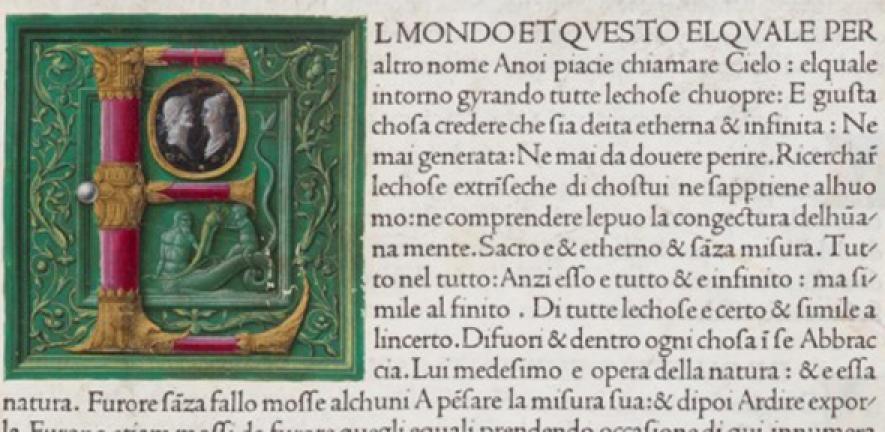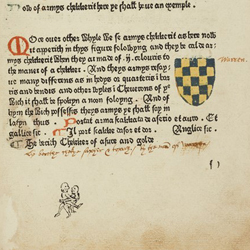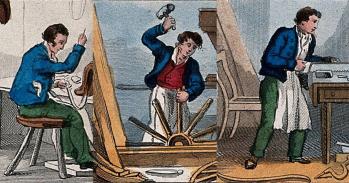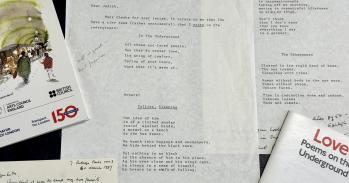
A copy of the first western printed book, the prayer book of Henry VIII’s last wife and an unpublished poem by Carol Ann Duffy go on display in a celebration of the 15th century at Cambridge University Library.
A copy of the first western printed book, the prayer book of Henry VIII’s last wife and an unpublished poem by Carol Ann Duffy go on display in a celebration of the 15th century at Cambridge University Library.
There is a temptation to view these marginalia and doodles as diminishing, but it’s precisely these features that make early printed books a joy to study. They offer rare and fascinating insights into the private lives of books.
Ed Potten
A unique copy of the Gutenberg Bible – Europe’s first printed book using moveable type – is to go on display in a spectacular exhibition charting how books were simultaneously cherished and embellished, mistreated and even vandalised, in the first century of the printed age.
Private Lives of Print: The use and abuse of books 1450-1550 opens to the public at Cambridge University Library on October 24. It examines how the earliest owners of books produced with the new technology of print interacted with their books, and features some of the University Library’s most lavish printed treasures, many never before displayed.
The hand-coloured copy of the Nuremberg Chronicle, the most heavily illustrated book of the 15th century, sits alongside a Book of Hours annotated by Katherine Parr, the last wife of Henry VIII, and an exceptional copy of the Book of St Albans, the first colour printed book in English. 
The Book of St Albans, printed in St Albans in the mid-1480s and attributed to the prioress of nearby Sopwell, is a gentleman’s guide to heraldry, hawking and hunting. It is one of the most famous and collectable books in the history of English printing. An early owner of the Cambridge copy was oblivious to its future value; at the foot of an otherwise untarnished page is a pencil sketch of a passionate couple in flagrante delicto.
Annotations elsewhere indicate a more scholarly interaction between reader and book. Also on display is Cambridge’s copy of the Hypnerotomachia poliphili, an eccentric romance poem, considered by many to be the most beautifully designed book of the Renaissance. In 1518, a 16-year-old owner was moved by the Hypnerotomachia to compose his own poem in the front of Cambridge University Library’s copy of the book.
Alongside this 16th-century composition is displayed the text of a poem specially composed for the Library by Poet Laureate Carol Ann Duffy, who was inspired by a visit to the Library to study the Hypnerotomachia. An extract of Carol Ann Duffy’s poem, which is being published for the first time in a new Library publication celebrating its early printed treasures, Emprynted in thys manere, reads:
“And yet,
that evening in the emptying Library, the human chain,
from Venice 1499 to here and now, joined
warm and open palms to yours, a living link
around the precious charm of a book.
Woodcutter to printer; ink’s solemn vow to page;
word and image in their beautiful Renaissance dance.”
Embellishment and decoration form another strand of the exhibition. Early printers mimicked the products of the flourishing manuscript trade and consequently many early printed books were painstakingly decorated by hand. The exhibition features striking illuminations from some of the leading Italian artists of the period, including the Master of the London Pliny. Initials decorated in gold, red, blue and green are as vivid today as when they were originally executed for religious houses and members of the nobility, and royal houses of Europe, some 500 years ago.
All of the 54 exhibits going on display demonstrate the differing relationships between the earliest printed books and their owners. From marginal drawings of plants and animals and sketches of classical architecture, to the clumsy reader who in 1482 confessed to spilling red ink on his clean page; visitors to the exhibition will find the work of careful hands as well as careless ones.
Exhibition curator Ed Potten said: “We tend to assume that books of this age and importance have always been treasured items treated with the utmost respect and care – but we forget that books were constantly being read, handed down, sold and scribbled upon. Many of the early printed books owned by the Library have every spare space covered with notes and scribbles.
“There is a temptation to view these marginalia and doodles as diminishing and devaluing the books, but it’s precisely these features that make them a joy to study. They offer rare and fascinating insights into the private lives of books – glimpses of the many ways in which books were received and subsequently used by the first generations of printed book owners.”
In parallel with the exhibition, the University Library is launching its latest print publication, Emprynted in thys manere: Early printed treasures from Cambridge University Library. Published to celebrate the conclusion of a five-year research project to catalogue Cambridge’s world-class collections of 15th-century books, it comprises essays by 60 contributors.
Historians, authors, artists and academics from around the world have each chosen their favourite object from Cambridge’s printed collections, many of which also feature in Private Lives of Print. Sir Quentin Blake describes being transported to “a different world, breathing a different air” by the experience of viewing the Library’s beautifully illuminated edition of Sabellicus. Professor Eamon Duffy, the renowned scholar of the Reformation, describes Katherine Parr’s annotated Book of Hours, “its inscriptions … a poignant monument”.
The 60 items featured are described over 176 pages and illustrated by 200 full-colour photographs, making the book a fitting tribute to the Library’s remarkable printed collections.
Private Lives of Print runs until 11 April 2015. For details of opening hours go to https://exhibitions.lib.cam.ac.uk/
Inset images: a surprising doodle in the margin of the Book of St Albans (Inc.3.J.4.1[3636]); an ink blot: "I stupidly made this blot on the first of December 1482" (Inc.1.B.3.1b[1330]) (Cambridge University Library)
The text in this work is licensed under a Creative Commons Licence. If you use this content on your site please link back to this page. For image rights, please see the credits associated with each individual image.





